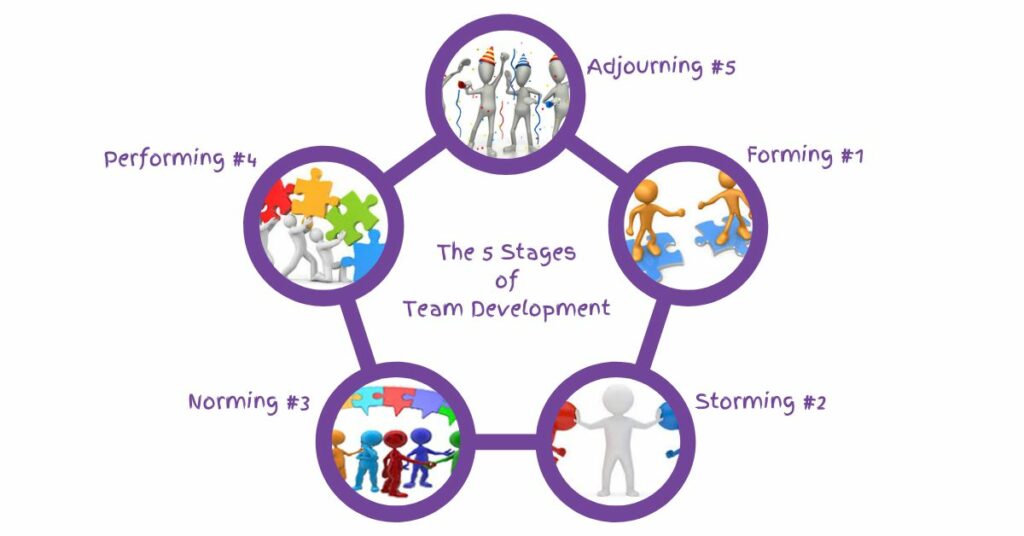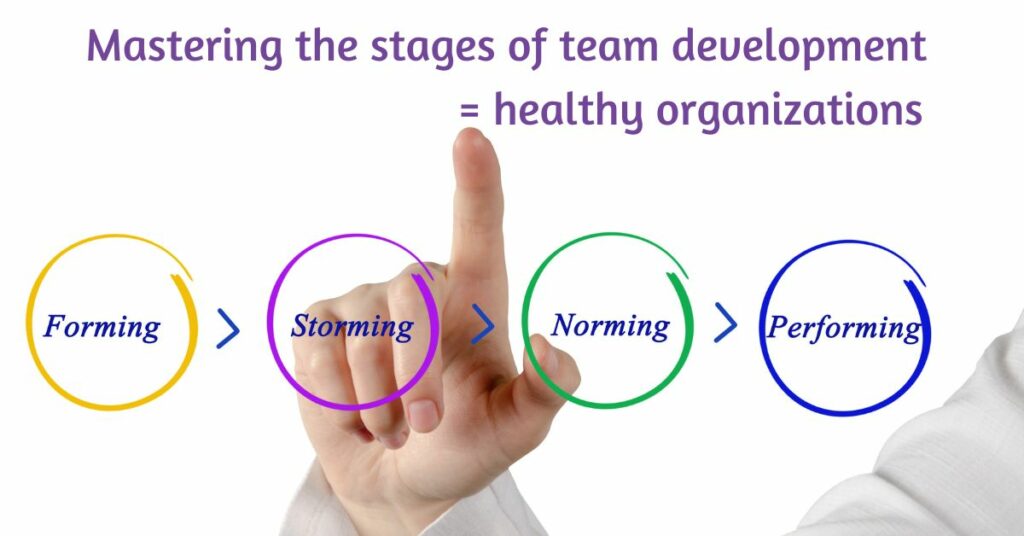Developed by psychologist Bruce W. Tuckman in the 1960s, the five stages of team development are commonly used to understand team performance. As the saying goes, teamwork makes the dream work. This model provides a valuable framework to help a team understand how they can improve.
For teams to achieve optimal performance, they must go through five very distinct stages of development:
- Forming
- Storming
- Norming
- Performing
- Adjourning
Mastering these stages is crucial for any organization looking to achieve its best.
Each stage presents unique challenges, from understanding a team’s personalities and roles to navigating conflict and establishing norms. By recognizing and strategically addressing these challenges, team leaders can create a cohesive, high-performing team capable of achieving even the loftiest goals.
So, whether you’re a seasoned team leader or just starting, it’s time to dive into these five stages of team development and take your organization to the next level.
Stage 1:
Forming – Building relationships and establishing goals
The forming stage is the first step in team development. At this stage, team members are just getting to know each other, and everyone is eager to make a good impression. The focus is on building relationships and establishing goals. During this stage, team members are usually polite and respectful toward each other. They are also excited about the project and eager to get started.
However, this stage can also be uncertain and anxious, as team members still need to get to know each other, build trust, and learn their roles and responsibilities.
As a team leader, it’s essential to set clear goals and expectations so everyone knows what they are working towards. It’s also important to establish open lines of communication so that team members can share their thoughts and ideas freely.
In forming, team leaders should encourage team members to get to know each other through team-building activities or simple icebreakers. By creating a sense of camaraderie and trust early on, team members will be more likely to work together effectively throughout the rest of the project.
Stage 2:
Storming – Navigating conflicts and establishing norms
The storming stage is often the most challenging stage of team development. At this stage, team members may feel frustrated or irritated with each other, leading to conflicts or disagreements about how to approach the project. It’s important to remember that conflicts are a natural and vital part of the team development process and often are a sign of progress. Conflicts often arise when team members assert themselves and their ideas.
As a team leader, it’s essential to navigate conflicts carefully by establishing norms and guidelines for how team members should interact. It’s also important to encourage team members to listen to each other’s perspectives and work together to find the best possible solution for the team.
Another critical aspect of the storming stage is establishing clear roles and responsibilities for team members to manage conflict and ensure everyone is clear on supporting the team’s goals. By being clear on expectations early on, team members will be better equipped to work together effectively throughout the rest of the project.
Stage 3:
Norming – Establishing cohesion and unity in the team
The norming stage is all about establishing cohesion and unity within the team. Team members have worked through conflict and demonstrated clear roles and responsibilities at this stage. They are now able to work together more effectively towards the project goals.
During the norming stage, it’s important to celebrate successes and acknowledge the hard work team members have put in, helping build morale and keeping people motivated. It’s also important to continue communicating openly and honestly so everyone is on the same page.
During the norming stage, team leaders should encourage collaboration and cooperation by being clear about goals and motivating team members to work together to achieve them. By doing so, team members can establish trust and unity that will carry them through the rest of the project.
Stage 4:
Performing – Achieving goals and delivering results
The performing stage is where the team starts to shine. At this stage, team members work together effectively towards the project goals, delivering results and achieving success.
Team members must be motivated and focused to make the most of the performing stage by recognizing and rewarding individual and team achievements. It’s also important to continue communicating openly and honestly so everyone knows the team’s progress.
Another vital aspect of the performing stage is monitoring and evaluating the team’s performance through regular check-ins and assessments. By doing so, team leaders can identify areas that need improvement and make necessary adjustments.
Stage 5:
Adjourning – Reflecting on the team’s achievements and moving forward
The adjourning stage is the final stage of team development. At this stage, the project ends, and team members reflect on their achievements. The end of a project can be bittersweet, as team members may have developed close relationships with each other throughout the project.
Team leaders are encouraged to celebrate team achievements and acknowledge the hard work everyone has contributed. It’s also imperative to take the time to reflect on what worked well and what didn’t to inform future projects and ensure the team continues to grow and develop.
Five Stages of Team Development
Common challenges during each stage and the role of leadership in overcoming them.
Each stage presents unique challenges. During forming, team members may need clarification on their roles and responsibilities. The storming stage is where conflicts may arise as team members assert themselves. In the norming stage, team members may become complacent or lose focus. Team members may need to be more confident or complacent during the performing stage. And finally, in the adjourning stage, team members may feel a sense of loss or sadness.
The role of leadership is crucial in guiding teams through each stage of development. There are a few essential strategies to overcome these challenges:
- Establish clear goals and expectations.
- Navigate conflicts and challenges as they arise.
- Encourage collaboration and cooperation.
- Be willing to make necessary adjustments as the project progresses.
- Recognize and reward individual and team achievements.
The importance of effective communication in team success.
Effective communication is critical when developing a successful team to prevent team members from becoming confused and frustrated, often leading to conflicts, misunderstandings, and disengagement.
As a leader, ensuring your communication is effective involves:
- Listening actively.
- Sharing information openly and honestly.
- Providing feedback in a constructive and supportive manner.
By doing so, team members can establish trust and unity, providing a vital foundation for them to work together more effectively and stay aligned around project goals.
Benefits of mastering the five stages of team development.
Mastering the five stages of team development provides many benefits for organizational success. These benefits include:
- Increased productivity and efficiency
- Improved morale and motivation
- Greater innovation and creativity
- Stronger relationships among team members
- Enhanced problem-solving and decision-making skills
A culture of teamwork and collaboration is achievable with an understanding of these five stages of team development.
At NexLevel, we’re experts in helping leaders Build Healthy and Effective Organizations with Aligned Leaders, Cohesive Teams & Engaged Employees.
We will help you and your employees become the high-performance team you’ve always wanted to be by focusing on collaboration, creativity, culture, and connection.




